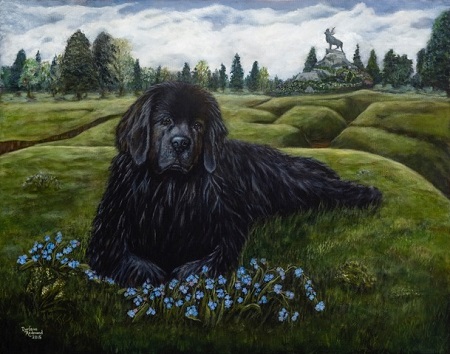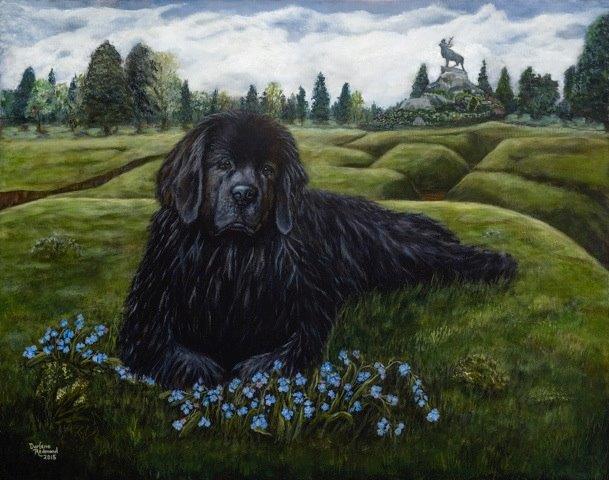Lesson plan: Sable Chief – A comforting mascot
Aim
To increase youth awareness of the Battles of the Somme and Beaumont-Hamel in the First World War. Remembering the sacrifices and achievements made by the people of Newfoundland and Labrador.
Objectives
Youth will be expected to:
- develop a basic understanding of the Canadian efforts at the Battles of the Somme and Beaumont-Hamel;
- develop an awareness of the importance of Memorial Day (July 1st) in Newfoundland;
- develop an awareness of the importance of remembering the sacrifices and achievements of those who served and died on the battlefield of Beaumont-Hamel during the Battle of the Somme in 1916; and
- understand the important roles animal pets had in the war by gaining the affection of the soldiers on the battlefields as mascots and reminding them of their lives back home.
Target audience
This activity is suitable for ages 8 to 11.
Sequence of events and anticipated time frame [45 minutes]
(This activity can be modified to fit available time.)
- Introductory discussion [10 minutes]
- Read aloud – Sable Chief – A Comforting Mascot [15 minutes]
- Caribou cruncher paper activity [20 minutes]
- Sable Chief colouring sheet [optional]
Materials
- “Sable Chief – A comforting mascot” story
- World map (PDF) showing Europe/France and North America/Newfoundland
- The Newfoundland Regiment and the Battle of Beaumont-Hamel fact sheet
- Instructions for the Caribou cruncher paper activity
- Caribou cruncher paper activity (PDF)
- Image “Forget-Me-Not” of the painting by Darlene Redmond
- Sable Chief – A comforting mascot colouring sheet (PDF)
Introductory discussion [10 minutes]
Before introducing the Battles of the Somme and Beaumont-Hamel to your students, you may wish to read the fact sheet the Newfoundland Regiment and the Battle of Beaumont-Hamel to familiarize yourself with Canada’s efforts there.
Brainstorm with youth on what they know about wars. Do they know of any times when our country has had to fight in a conflict? Have they heard of the First and Second World Wars? You may wish to record their responses.
Show where France is on a map and how far away it is from your home province or territory. Explain how wars are hard and very dangerous for those who serve in them. You could discuss things like the terrain or share other basic information about the battle and the bravery of those who fought to help set the stage for the Cruncher Paper and / or colouring activity.
Share that the Battles of the Somme and Beaumont-Hamel started on July 1st, 1916, and it is an important milestone. More than 100 years later, Canada still remembers those who served and sacrificed in this battle.
Explain that in the time of the First World War, Newfoundland and Labrador was not a province of Canada. It was a Dominion of Great Britain. However, Newfoundland and Canadian soldiers fought in many difficult battles, like the Battle of the Somme. The Canadians did not fight on the opening day of the battle, but the Newfoundlanders did, and sadly, it was a day where many men lost their lives. The soldiers had to stay on and keep fighting in the war. This was difficult because they had lost so many friends on July 1st and were sad.
Read aloud & follow-up discussion [15 minutes]
Read aloud or hand out the story of Sable Chief – A comforting mascot, about the Newfoundlanders’ mascot and how he helped to boost their morale following that terrible day and for the rest of the war.
Follow up with a short discussion. How do students feel about the story? Do students have pets at home? If they are having a bad day, can they count on a hug or a lick from their pet? Do they make them laugh? Could they imagine that a mascot dog would make them feel better if they were sad and far away from home?
Discuss the painting “Forget-Me-Not” that’s on the handout. Can youth find the symbols of remembrance in the painting (for example, the Caribou Monument on the mound in the background at Beaumont-Hamel park, and the forget-me-not flowers in the forefront?) Talk about how the Newfoundland dog Sable Chief mascot helped the soldiers feel better, and the blue forget-me-not flowers and the Caribou Monument helped their families at home feel better. You could also mention that the bumps and crevices in the grass are the preserved battlefield and trench systems that still exist at Beaumont-Hamel park today.
Cruncher paper activity [15 minutes]
Provide students with a Caribou cruncher paper activity handout and Caribou cruncher instruction sheet. The cruncher is a fun activity that will help children learn more about the mascot Sable Chief and the Newfoundland Regiment at the Battles of the Somme and Beaumont-Hamel.
Follow-up colouring activity [optional]
Provide each student with the Sable Chief colouring sheet and allow time to colour Sable Chief at Beaumont-Hamel park with the forget-me-not flowers in the forefront, and the Caribou Monument behind.
- Date modified:

